Investigation of the Successive Ozone Episodes in the El Paso–Juarez Region in the Summer of 2017
Abstract
1. Introduction
2. Methodology
2.1. Site Description
2.2. Ceilometer CL-31
2.3. Modeling Planetary Boundary Layer Heights
2.3.1. Weather Research and Forecasting (WRF)
2.3.2. Hybrid Single Particle Lagrangian Integrated Trajectory Model (HYSPLIT)
3. Results
3.1. Classification of the Regional Ozone Episodes
3.2. Heat Deficit Calculation during the High Ozone Event Relative to the Low Ozone Event
3.3. Behavior of PM, NOx, VOCs, and Relative Humidity during the Ozone Events
3.4. Winds and Related Synoptic Analysis during the Episodes
3.5. Aerosol Layer Structure and Its Evolution during the Aerosol Events
3.6. Correlation between Boundary Layer Heights, Ozone, and Other Aerosols Concentrations
4. Discussion
5. Conclusions
Author Contributions
Funding
Acknowledgments
Conflicts of Interest
References
- Stewart, D.R.; Saunders, E.; A Perea, R.; Fitzgerald, R.; E Campbell, D.; Stockwell, W.R. Linking Air Quality and Human Health Effects Models: An Application to the Los Angeles Air Basin. Environ. Health Insights 2017, 11, 1178630217737551. [Google Scholar] [CrossRef] [PubMed]
- Pearson, R.; Fitzgerald, R. Application of a Wind Model for the El Paso-Juarez Airshed. J. Air Waste Manag. Assoc. 2001, 51, 1096–2247. [Google Scholar] [CrossRef] [PubMed]
- Shi, C.; Fernando, H.J.S.; Yang, J. Contributors to ozone episodes in three U.S./Mexico border twin-cities. Sci. Total Environ. 2009, 407, 5128–5138. [Google Scholar] [CrossRef]
- Medina, R.; Fitzgerald, R.; Min, Q. Retrieval of the single scattering albedo in the El Paso-Juarez Airshed using the TUV model and a UV-MFRSR radiometer. Atmos. Environ. 2012, 46, 430–440. [Google Scholar] [CrossRef]
- Macdonald, C.P.; Roberts, P.T.; Main, H.H.; Dye, T.S.; Coe, D.L.; Yarbrough, J. The 1996 Paso del Norte Ozone Study: Analysis of meteorological and air quality data that influence local ozone concentrations. Sci. Total. Environ. 2001, 276, 93–109. [Google Scholar] [CrossRef]
- Stockwell, W.R.; Lawson, C.V.; Saunders, E.; Goliff, W.S. A Review of Tropospheric Atmospheric Chemistry and Gas-Phase Chemical Mechanisms for Air Quality Modeling. Atmosphere (Basel) 2011, 3, 1–32. [Google Scholar] [CrossRef]
- Stewart, D.; Saunders, E.; Perea, R.; Fitzgerald, R.; Campbell, D.E.; Stockwell, W.R. Projected changes in particulate matter concentrations in the South Coast Air Basin due to basin-wide reductions in nitrogen oxides, volatile organic compounds, and ammonia emissions. J. Air Waste Manag. Assoc. 2018, 69, 192–208. [Google Scholar] [CrossRef]
- Stockwell, W.R.; Saunders, E.; Goliff, W.S.; Fitzgerald, R.M. A perspective on the development of gas-phase chemical mechanisms for Eulerian air quality models. J. Air Waste Manag. Assoc. 2019, 70, 44–70. [Google Scholar] [CrossRef]
- Goliff, W.S.; Luria, M.; Blake, D.R.; Zielinska, B.; Hallar, A.G.; Valente, R.J.; Lawson, C.V.; Stockwell, W.R. Nighttime air quality under desert conditions. Atmos. Environ. 2015, 114, 102–111. [Google Scholar] [CrossRef]
- Kim, D.; Loughner, C.; Wetzel, M.A.; Goliff, W.S.; Stockwell, W.R. A comparison of photolysis rate parameters estimated from measured and simulated actinic flux for wintertime conditions at Storm Peak Laboratory, Colorado. J. Atmos. Chem. 2007, 57, 59–71. [Google Scholar] [CrossRef]
- Saylor, R.D. An estimate of the potential significance of heterogeneous loss to aerosols as an additional sink for hydroperoxy radicals in the troposphere. Atmospheric Environ. 1997, 31, 3653–3658. [Google Scholar] [CrossRef]
- Emeis, S. Analytical Description and Vertical Structure of the Atmospheric Boundary Layer. Air-Sea Exch. Phys. Chem. Dyn. 2011, 40, 9–32. [Google Scholar]
- Athanassiadis, G.A.; Rao, S.; Ku, J.-Y.; Clark, R.D. Boundary Layer Evolution and its Influence on Ground-Level Ozone Concentrations. Environ. Fluid Mech. 2002, 2, 339–357. [Google Scholar] [CrossRef]
- Brown, M.J.; Muller, C.; Wang, G.; Costigan, K. Meteorological simulations of boundary-layer structure during the 1996 Paso del Norte Ozone Study. Sci. Total. Environ. 2001, 276, 111–133. [Google Scholar] [CrossRef]
- Lu, D.; Reddy, R.S.; Fitzgerald, R.; Stockwell, W.R.; Williams, Q.L.; Tchounwou, P.B. Sensitivity Modeling Study for an Ozone Occurrence during the 1996 Paso Del Norte Ozone Campaign. Int. J. Environ. Res. Public Health 2008, 5, 181–203. [Google Scholar] [CrossRef] [PubMed]
- Stockwell, W.R.; Fitzgerald, R.; Lu, D.; Perea, R. Differences in the variability of measured and simulated tropospheric ozone mixing ratios over the Paso del Norte Region. J. Atmos. Chem. 2013, 70, 91–104. [Google Scholar] [CrossRef]
- Hicks, M.; Sakai, R.; Joseph, E. The Evaluation of a New Method to Detect Mixing Layer Heights Using Lidar Observations. J. Atmos. Ocean. Technol. 2015, 32, 2041–2051. [Google Scholar] [CrossRef]
- Karle, N.; Mahmud, S.; Fitzgerald, R.M.; Sakai, R.K.; Stockwell, W.R.; Demoz, B.B.; Morris, V.R. Analysis of Regional Meteorology During the Ozone Episodes in the El Paso—Juarez Airshed in the Summer of 2017. In Proceedings of the 99th American Meteorological Society Annual Meeting, Boston, MA, USA, 7 January 2019. [Google Scholar]
- Karle, N.; Mahmud, S.; Villalobos, C.; Labrado, N.; Fitzgerald, R.; Sakai, R.; Morris, V. Study of the Urban Heat Island and its Effect on the Planetary Boundary Layer for the El Paso-Juarez Airshed. AGUFM 2017, 2017. [Google Scholar] [CrossRef]
- Mahmud, S.; Wangchuk, P.; Fitzgerald, R.; Stockwell, W. Study of Photolysis Rate Coefficients to Improve Air Quality Models. Bull. Am. Phys. Soc. 2016, 61, 15. [Google Scholar]
- Münkel, C.; Eresmaa, N.; Räsänen, J.; Karppinen, A. Retrieval of mixing height and dust concentration with lidar ceilometer. Boundary-Layer Meteorol. 2007, 124, 117–128. [Google Scholar] [CrossRef]
- Tsaknakis, G.; Papayannis, A.D.; Mamouri, R.E. Atmospheric Measurement Techniques Inter-comparison of lidar and ceilometer retrievals for aerosol and Planetary Boundary Layer profiling over Athens, Greece. Atmos. Meas. Tech. 2011, 4, 1261–1273. [Google Scholar] [CrossRef]
- Compton, J.C.; Delgado, R.; Berkoff, T.A.; Hoff, R. Determination of planetary boundary layer height on short spatial and temporal scales: A demonstration of the covariance wavelet transform in ground-based wind profiler and lidar measurements. J. Atmospheric Ocean. Technol. 2013, 30, 1566–1575. [Google Scholar] [CrossRef]
- Hong, S.-Y.; Pan, H.-L. Nonlocal Boundary Layer Vertical Diffusion in a Medium-Range Forecast Model. Mon. Weather Rev. 1996, 124, 2322–2339. [Google Scholar] [CrossRef]
- Hong, S.-Y.; Noh, Y.; Dudhia, J. A New Vertical Diffusion Package with an Explicit Treatment of Entrainment Processes. Mon. Weather. Rev. 2006, 134, 2318–2341. [Google Scholar] [CrossRef]
- Mahmud, S.; Bhuiyan, A.M.; Sarmin, N.; Elahee, S. Study of wind speed and relative humidity using stochastic technique in a semi-arid climate region. AIMS Environ. Sci. 2020, 7, 156–173. [Google Scholar] [CrossRef]
- Hu, X.M.; Nielsen-Gammon, J.W.; Zhang, F. Evaluation of three planetary boundary layer schemes in the WRF model. J. Appl. Meteorol. Climatol. J. Appl. Meteorol. Clim. 2010, 49, 1831–1844. [Google Scholar] [CrossRef]
- Hong, S.-Y.; Dudhia, J.; Chen, S.-H. A Revised Approach to Ice Microphysical Processes for the Bulk Parameterization of Clouds and Precipitation. Mon. Weather Rev. 2004, 132, 103–120. [Google Scholar] [CrossRef]
- Tewari, M.; Chen, F.; Wang, W.; Dudhia, J.; Lemone, M.A.; Mitchell, K.E. Implementation and verification of the unified Noah land-surface model in the WRF model [presentation]. In Proceedings of the 20th Conference on Weather Analysis and Forecasting/16th Conference on Numerical Weather Prediction, Seattle, WA, USA, 11 January 2004. [Google Scholar]
- Monin, A.S.; Obukhov, A.M. Basic laws of turbulent mixing in the surface layer of the atmosphere. Contrib. Geophys. Inst. Slovak Acad. Sci. 1954, 24, 163–187. [Google Scholar]
- Kain, J.S.; Kain, J.S. The Kain–Fritsch Convective Parameterization: An Update. J. Appl. Meteorol. 2004, 43, 170–181. [Google Scholar] [CrossRef]
- Rolph, G.; Stein, A.; Stunder, B. Real-time Environmental Applications and Display sYstem: READY. Environ. Model. Softw. 2017, 95, 210–228. [Google Scholar] [CrossRef]
- Koracin, D.; Vellore, R.; Lowenthal, D.H.; Watson, J.; Koracin, J.; Mccord, T.; Dubois, D.; Chen, L.-W.A.; Kumar, N.; Knipping, E.M.; et al. Regional Source Identification Using Lagrangian Stochastic Particle Dispersion and HYSPLIT Backward-Trajectory Models. J. Air Waste Manag. Assoc. 2011, 61, 660–672. [Google Scholar] [CrossRef] [PubMed]
- Mukerjee, S.; Smith, L.A.; Norris, G.A.; Morandi, M.T.; Gonzales, M.; Noble, C.A.; Neas, L.M.; Özkaynak, A.H. Field Method Comparison between Passive Air Samplers and Continuous Monitors for VOCs and NO 2 in. J. Air Waste Manag. Assoc. 2004, 54, 307–319. [Google Scholar] [CrossRef] [PubMed]
- Whiteman, C.D.; Hoch, S.; Horel, J.D.; Charland, A. Relationship between particulate air pollution and meteorological variables in Utah’s Salt Lake Valley. Atmos. Environ. 2014, 94, 742–753. [Google Scholar] [CrossRef]
- Einfeld, W.; Church, H. Winter Season Air Pollution in El Paso-Ciudad Juarez. A Review of Air Pollution Studies in an International Airshed; Sandia National Laboratories: Albuquerque, NM, USA; Livermore, CA, USA, 1995. [Google Scholar]
- Calvert, J.; Orlando, J.; Stockwell, W.; Wallington, T. The Mechanisms of Reactions Influencing Atmospheric Ozone; Oxford University Press: New York, NY, USA, 2015. [Google Scholar]
- Fujita, E.M.; Campbell, D.E.; Stockwell, W.R.; Lawson, D.R. Past and future ozone trends in California’s South Coast Air Basin: Reconciliation of ambient measurements with past and projected emission inventories. J. Air Waste Manag. Assoc. 2013, 63, 54–69. [Google Scholar] [CrossRef]
- Wilczak, J.M.; Djalalova, I.; McKeen, S.; Bianco, L.; Bao, J.-W.; Grell, G.; Peckham, S.; Mathur, R.; McQueen, J.; Lee, P. Analysis of regional meteorology and surface ozone during the TexAQS II field program and an evaluation of the NMM-CMAQ and WRF-Chem air quality models. J. Geophys. Res. Space Phys. 2009, 114, D7. [Google Scholar] [CrossRef]
- Parsons, D.B.; Shapiro, M.; Hardesty, R.M.; Zamora, R.J.; Intrieri, J. The Finescale Structure of a West Texas Dryline. Mon. Weather Rev. 1991, 119, 1242–1258. [Google Scholar] [CrossRef][Green Version]
- Hu, X.-M.; Klein, P.; Xue, M. Evaluation of the updated YSU planetary boundary layer scheme within WRF for wind resource and air quality assessments. J. Geophys. Res. Atmos 2013, 118, 490–500. [Google Scholar] [CrossRef]
- Cuchiara, G.C.; Li, X.; Carvalho, J.; Rappenglück, B. Intercomparison of planetary boundary layer parameterization and its impacts on surface ozone concentration in the WRF/Chem model for a case study in Houston/Texas. Atmos. Environ. 2014, 96, 175–185. [Google Scholar] [CrossRef]
- Shen, L.; Mickley, L.J.; Gilleland, E. Impact of increasing heat waves on U.S. ozone episodes in the 2050s: Results from a multimodel analysis using extreme value theory. Geophys. Res. Lett. 2016, 43, 4017–4025. [Google Scholar] [CrossRef]
- Morris, G.A.; Ford, B.; Rappenglück, B.; Thompson, A.M.; Mefferd, A.; Ngan, F.; Lefer, B. An evaluation of the interaction of morning residual layer and afternoon mixed layer ozone in Houston using ozonesonde data. Atmos. Environ. 2010, 44, 4024–4034. [Google Scholar] [CrossRef]
- Caputi, D.J.; Faloona, I.C.; Trousdell, J.; Smoot, J.; Falk, N.; Conley, S. Residual layer ozone, mixing, and the nocturnal jet in California’s San Joaquin Valley. Atmos. Chem. Phys. 2019, 19, 4721–4740. [Google Scholar] [CrossRef]
- Banta, R.M.; Senff, C.J.; Alvarez, R.J.; Langford, A.O.; Parrish, D.D.; Trainer, M.; Darby, L.; Hardesty, R.M.; Lambeth, B.; Neuman, J.A. Dependence of daily peak O3 concentrations near Houston, Texas on environmental factors: Wind speed, temperature, and boundary-layer depth. Atmos. Environ. 2011, 45, 162–173. [Google Scholar] [CrossRef]
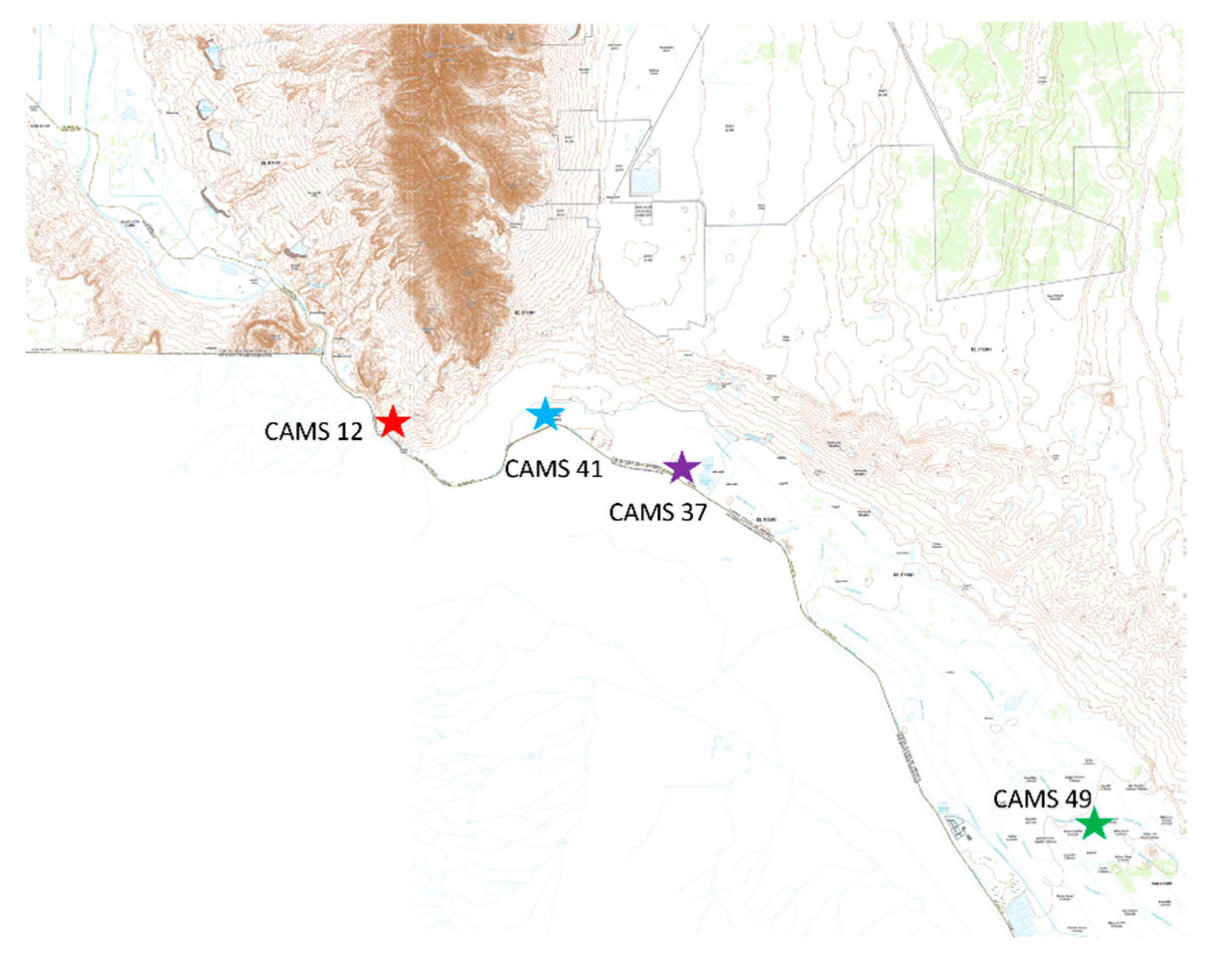

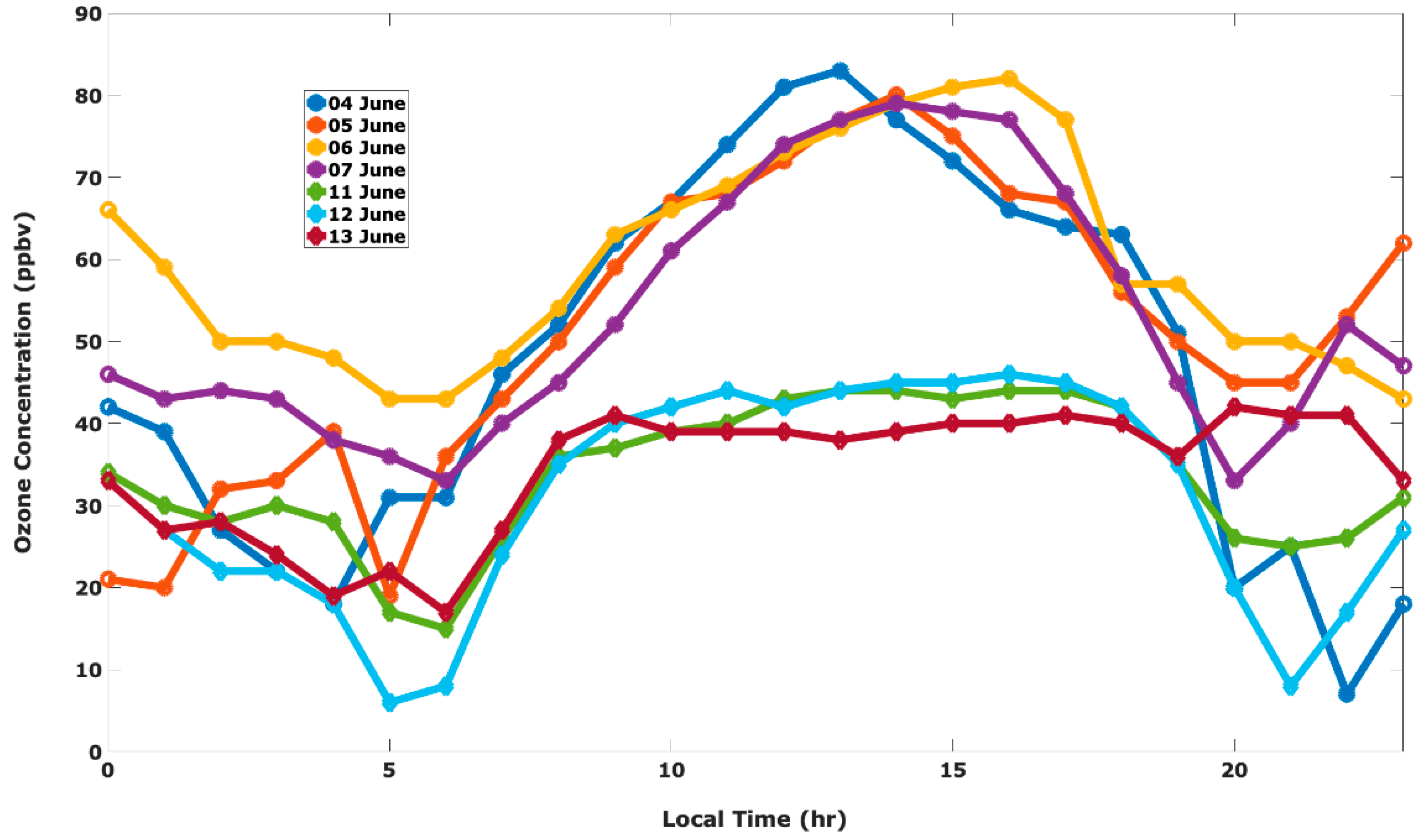
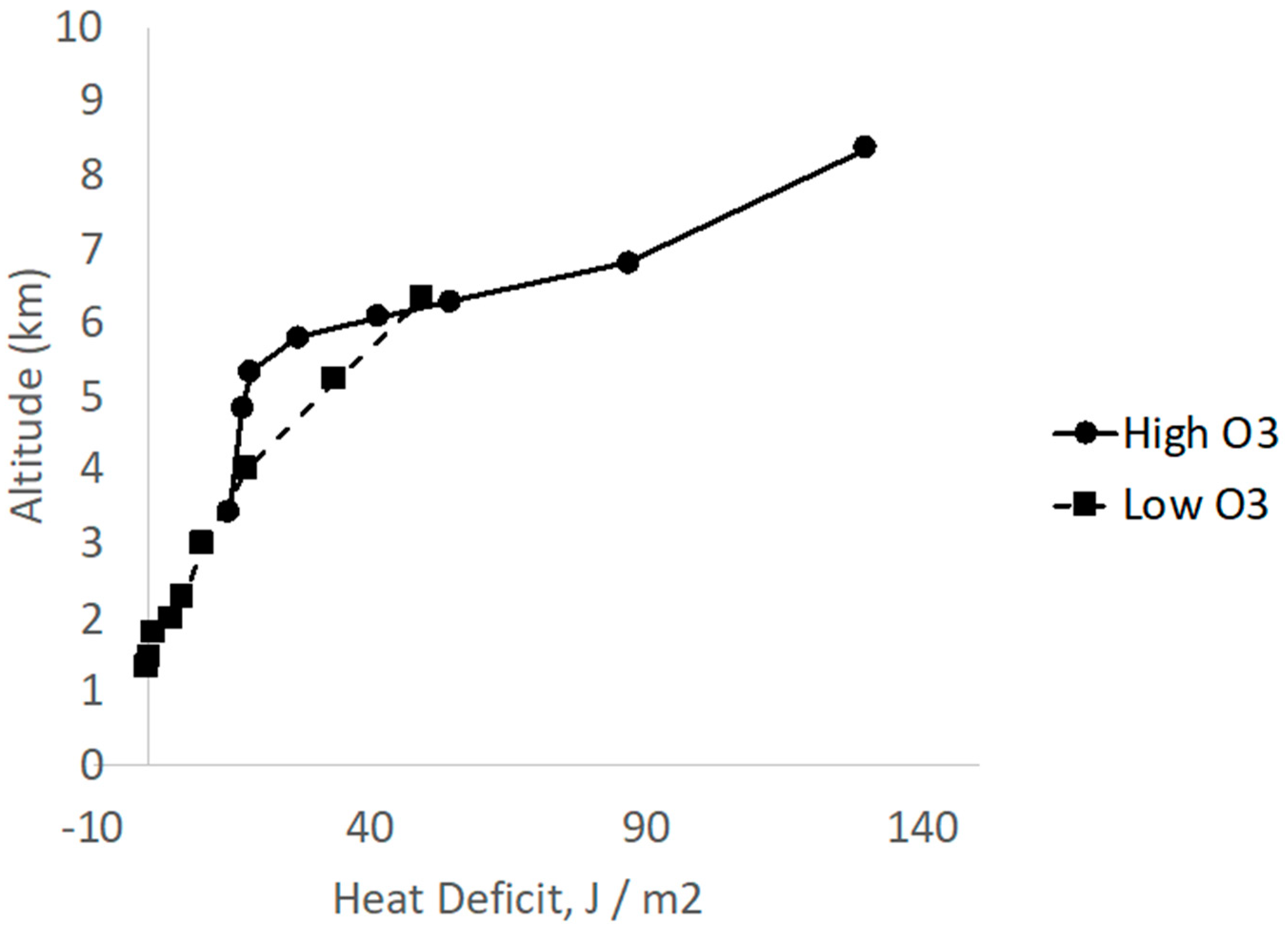
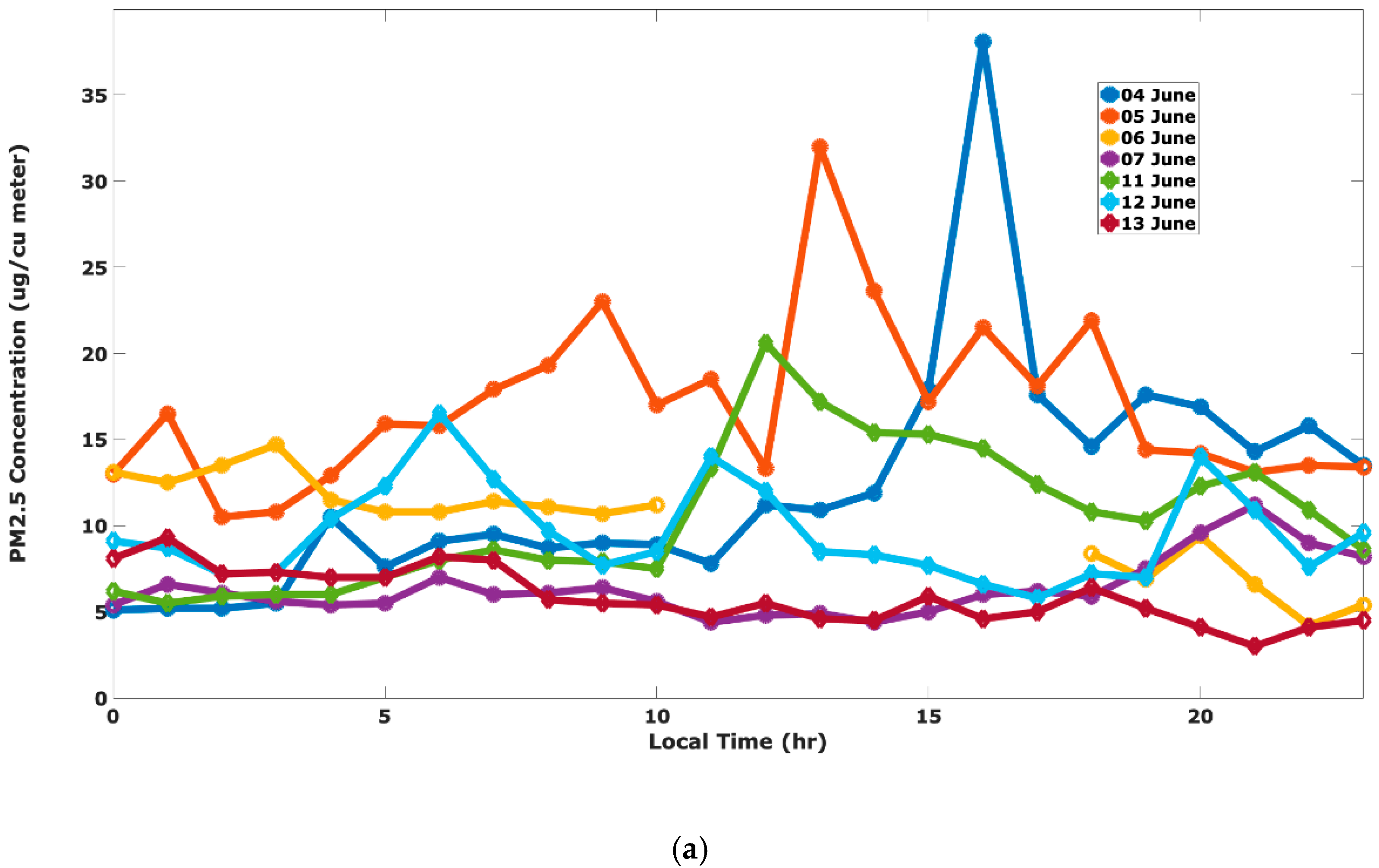
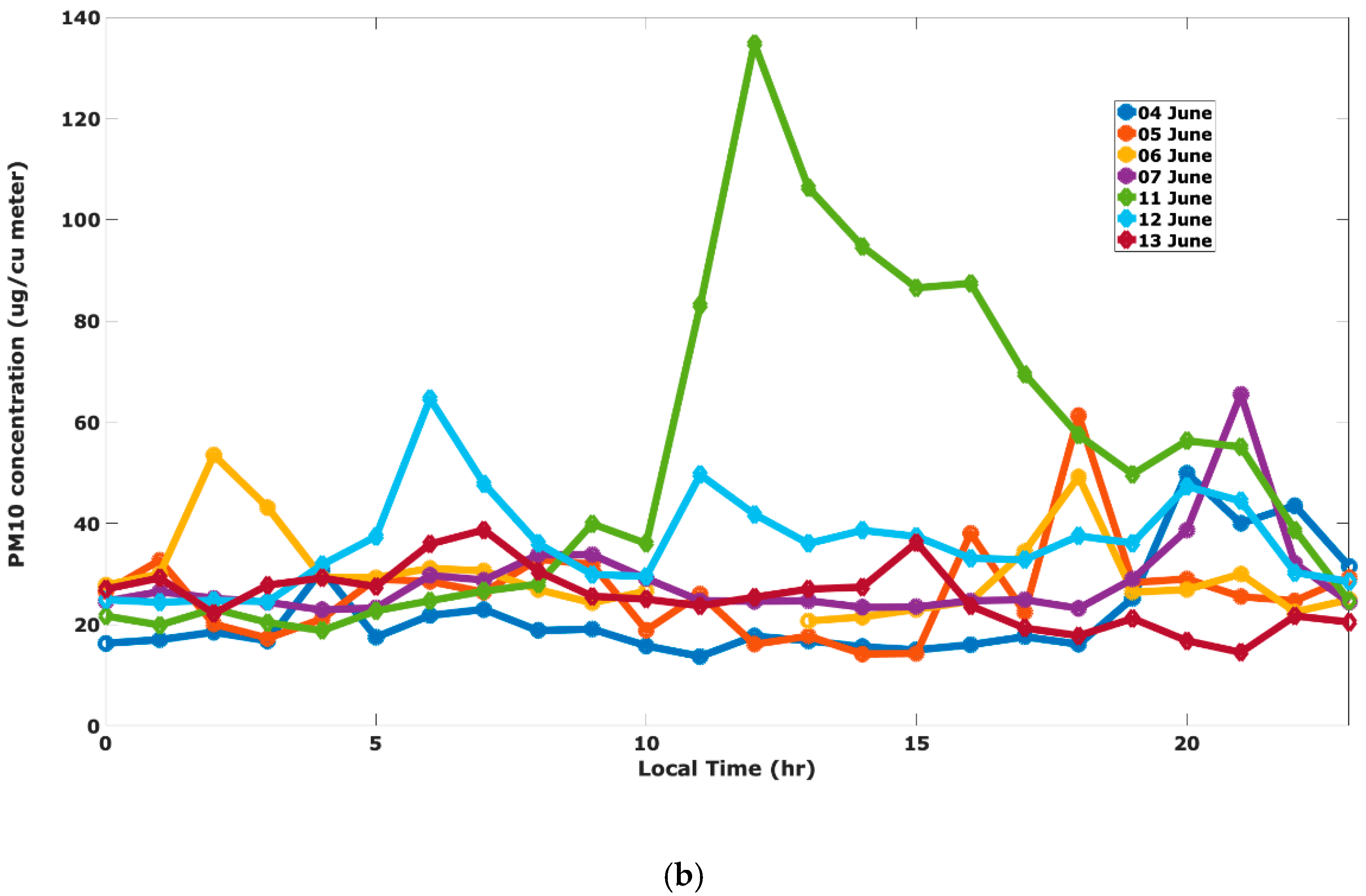
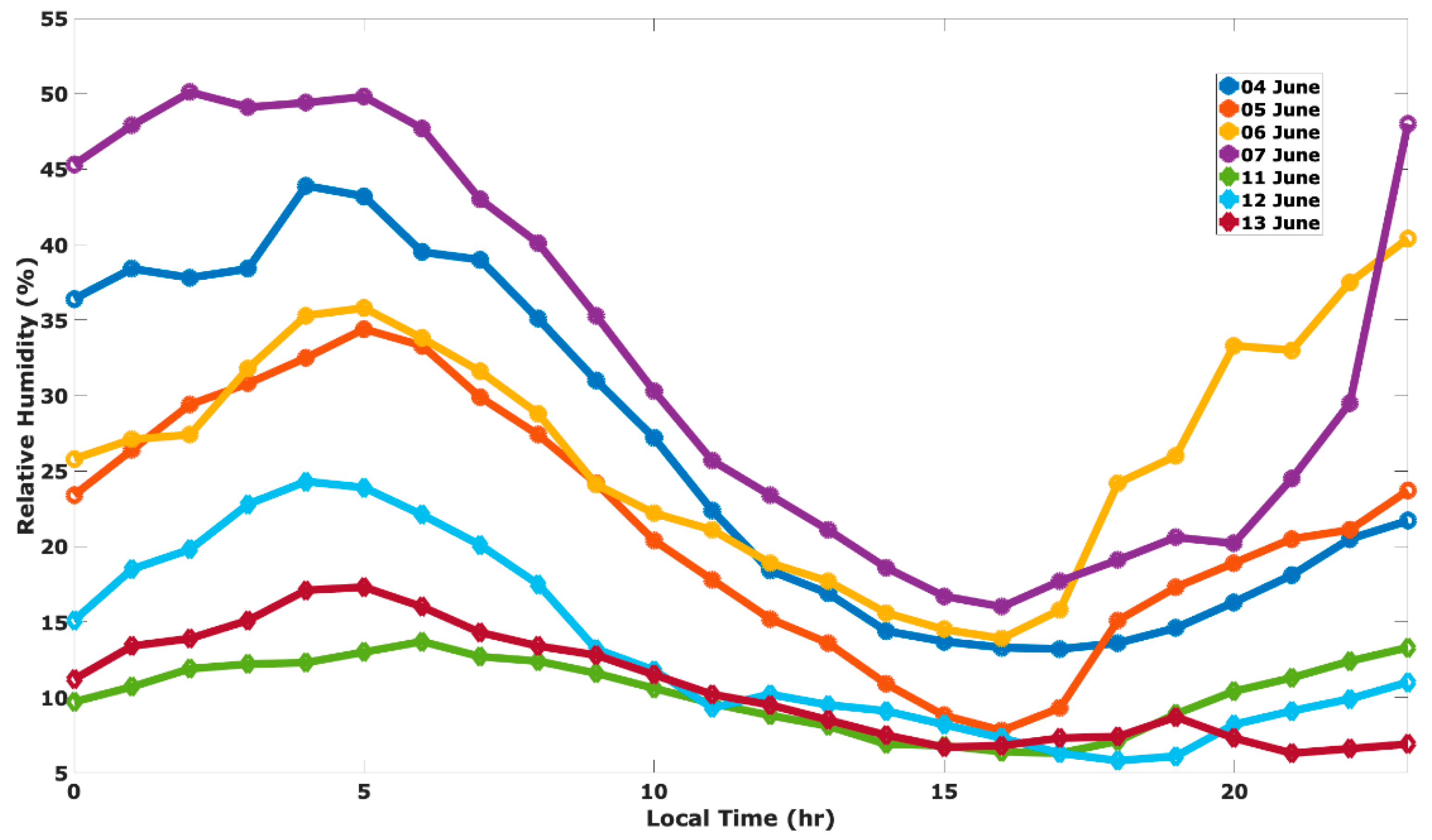

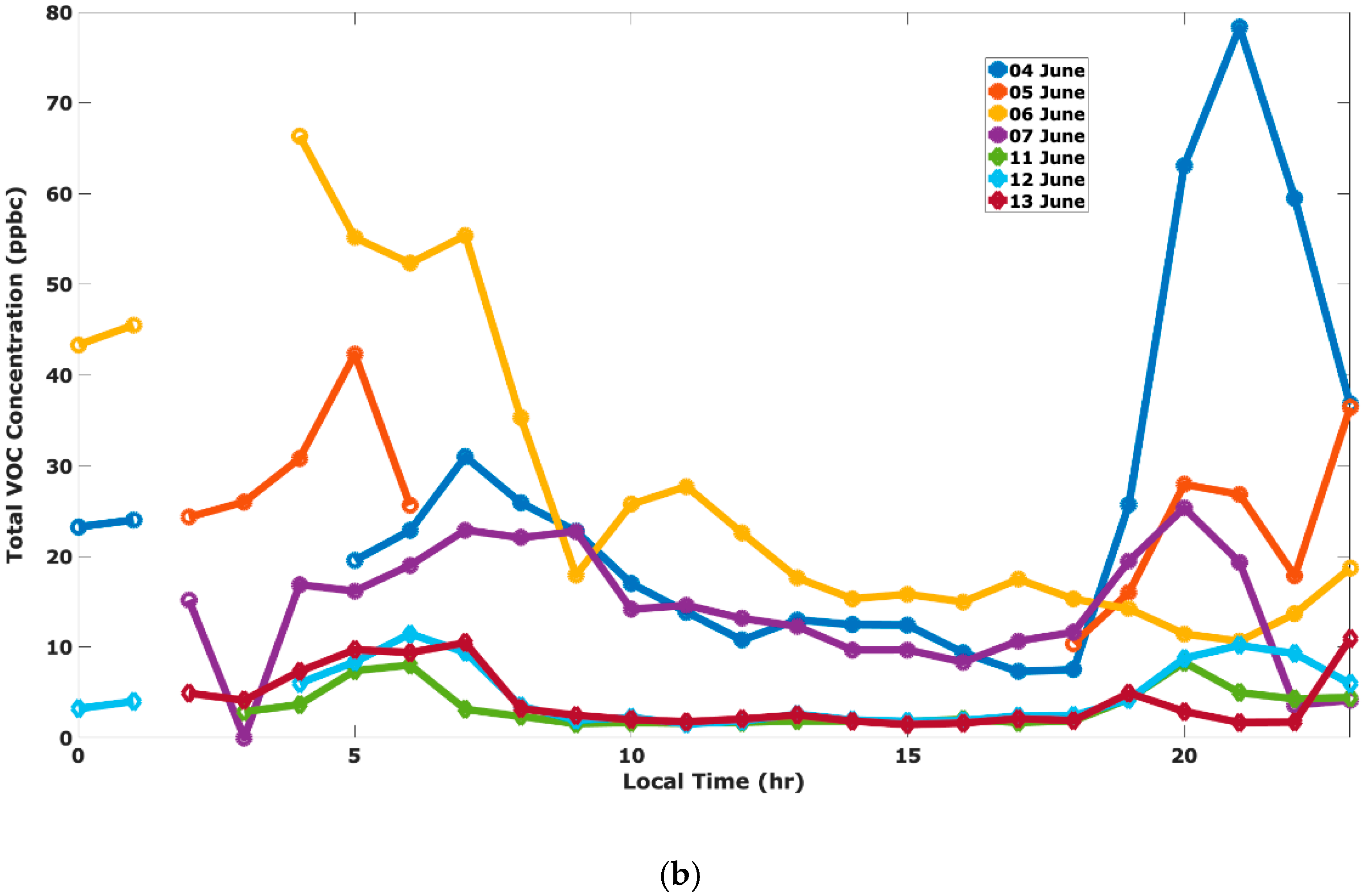
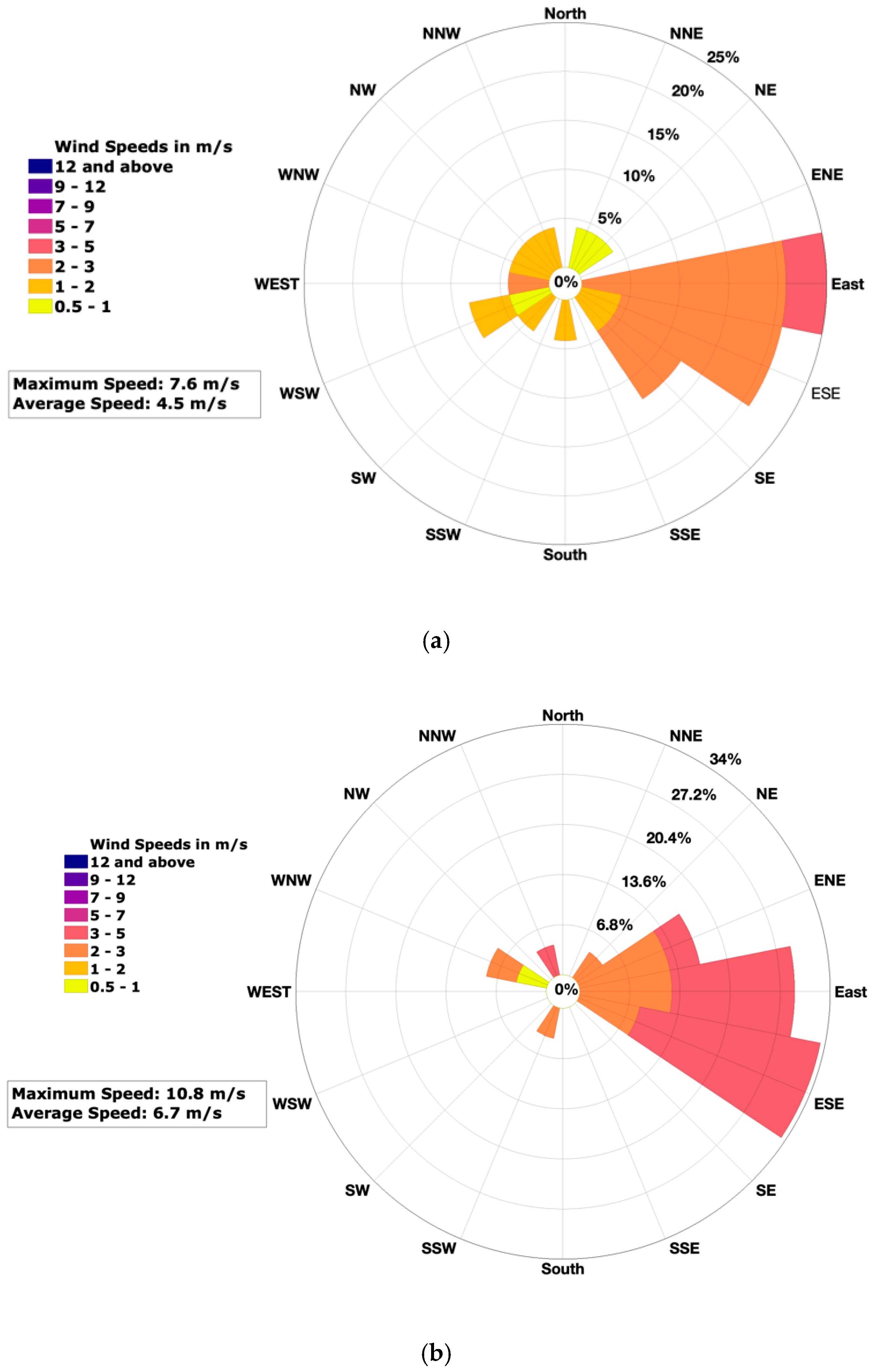
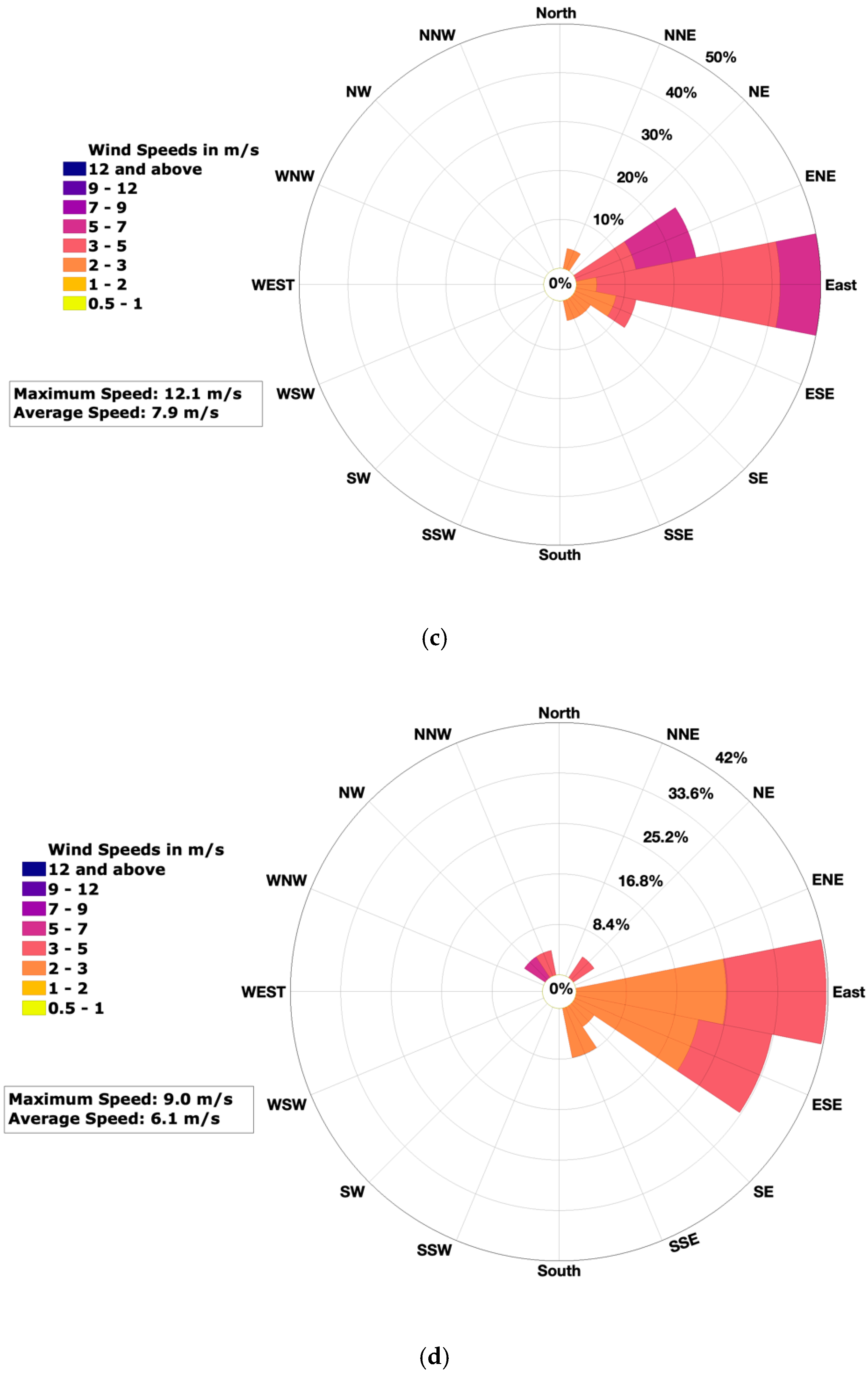


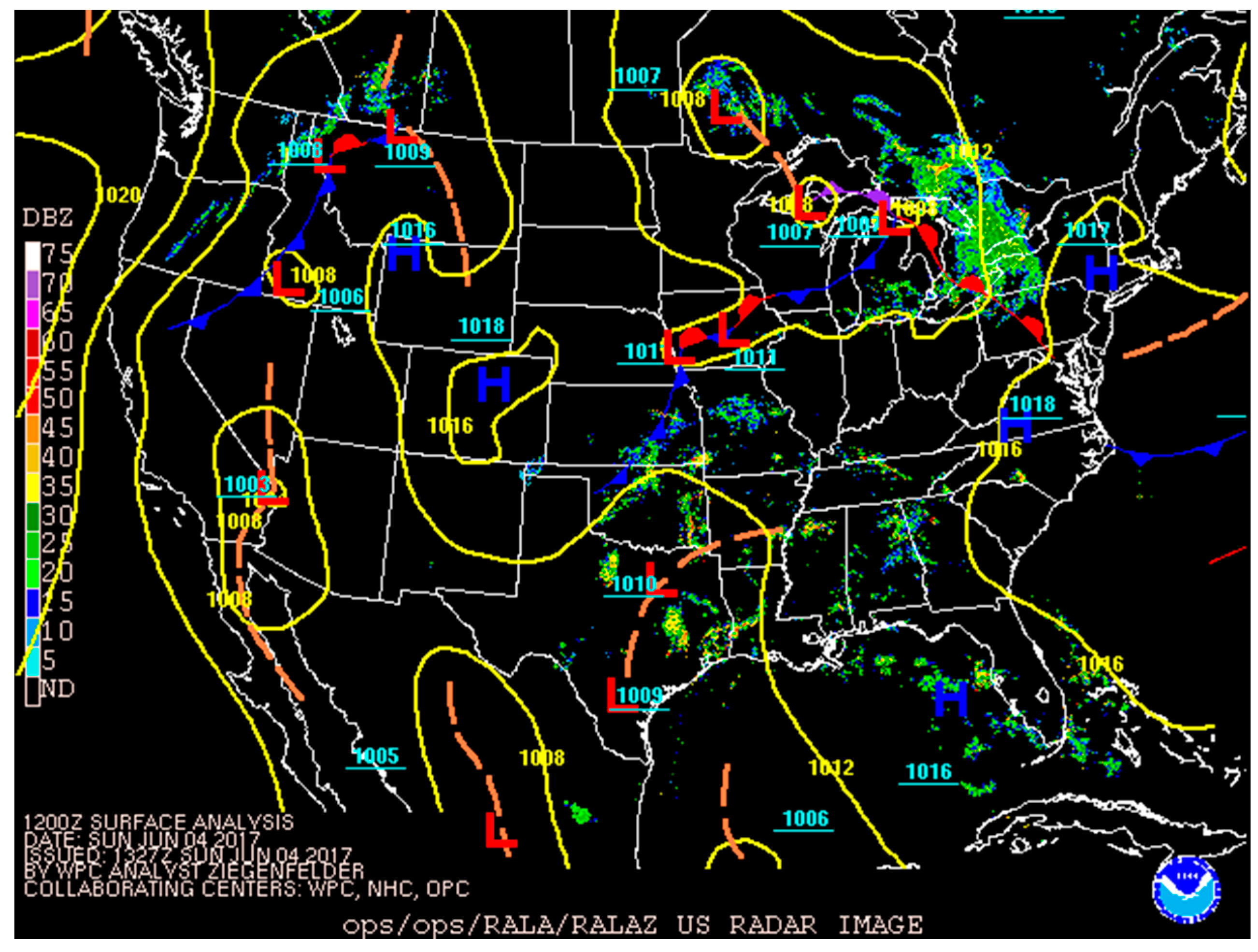
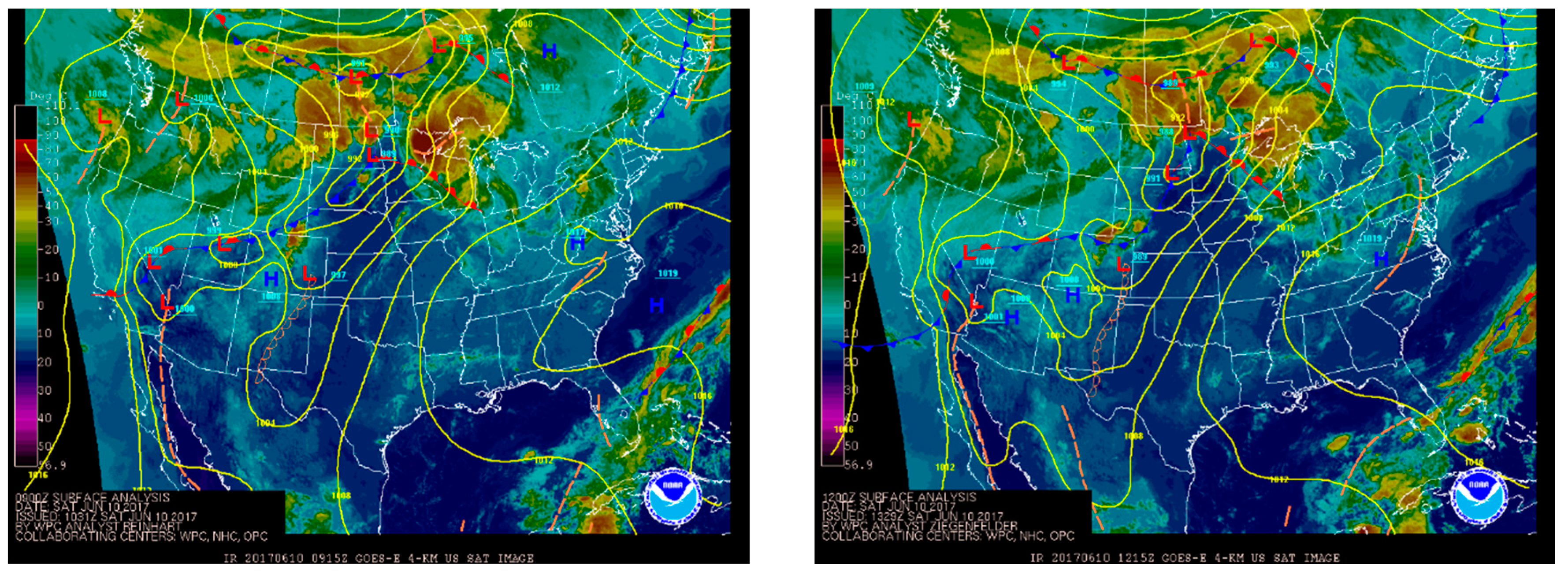
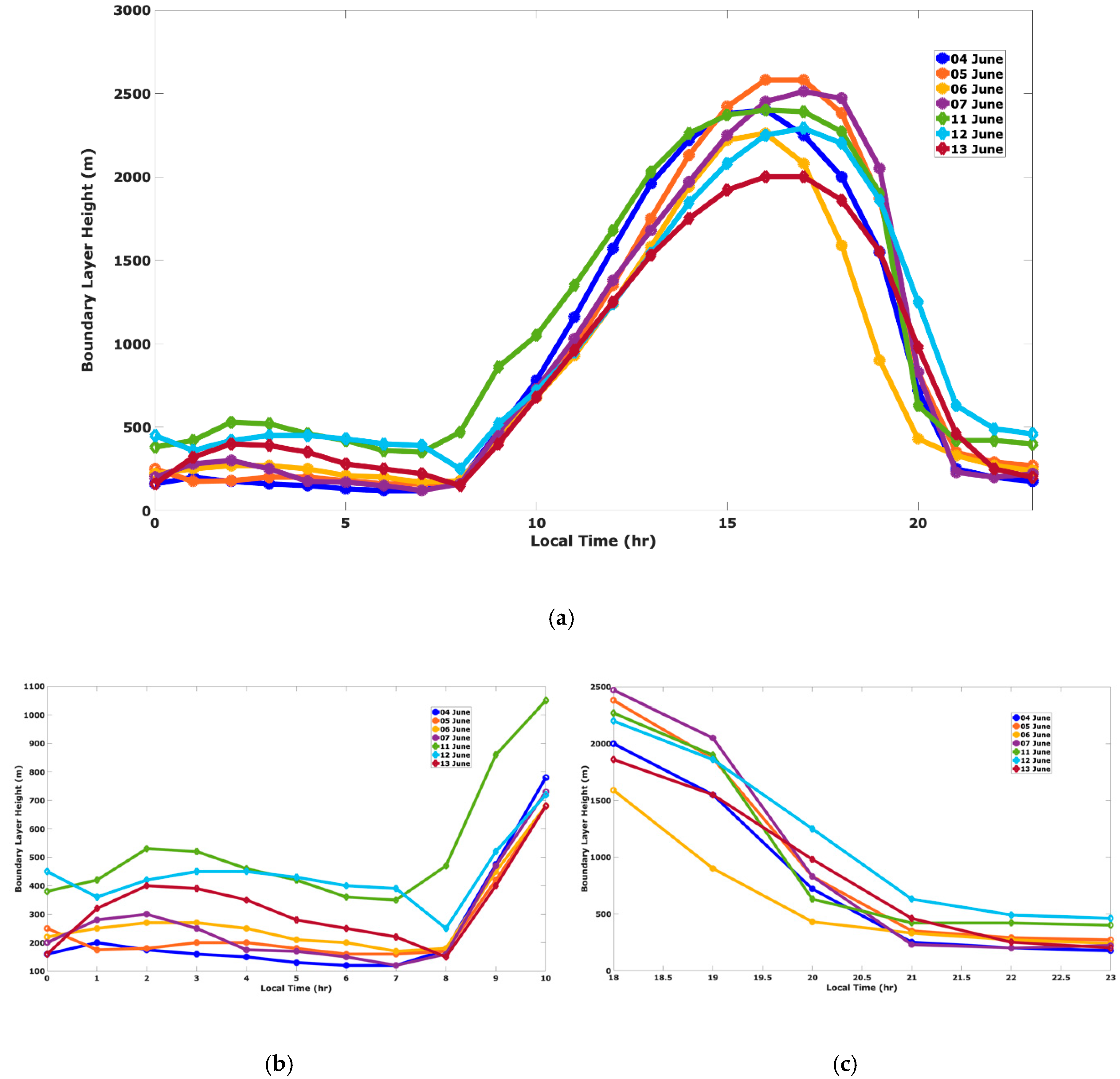

| Physics Scheme | WRF Option | References |
|---|---|---|
| Planetary Boundary Layer (PBL) | First Order Closure YSU (Yonsei University) | [25] |
| Microphysics | WRF Single-Moment (WSM) | [28] |
| Land Surface | Noah Land Surface | [29] |
| Surface Layer | Monin–Obukhov Similarity | [30] |
| Cumulus | Kain–Fritsch | [31] |
| Year | # of High Ozone Episodes | March | April | May | June | July | August | September |
|---|---|---|---|---|---|---|---|---|
| 2000 | 23 | - | 26 | 19–21, 28–30 | 1, 4, 7, 25 | 7, 9, 10, 18, 20, 28 | 1, 5, 19, 26, 27 | 3 |
| 2001 | 11 | 20 | 16 | - | 9 | 11, 25 | 4, 8, 19, 20, 25 | 5 |
| 2002 | 12 | - | 21, 22 | - | 1, 27, 29 | 3, 10, 21 | 3, 9 | 1, 2 |
| 2003 | 17 | - | - | - | 5, 14, 15, 18 | 1, 2, 4–6, 9, 13, 19, 21, 26 | 9, 10 | 6 |
| 2004 | 03 | - | - | - | - | 21, 30 | 4 | - |
| 2005 | 19 | - | - | 16, 21, 23 | 13, 14, 24, 29 | 8, 10, 14, 16, 17 | 10, 15, 16, 25, 27 | 9, 22 |
| 2006 | 20 | - | - | - | 2–5, 12, 17, 18, 27, 29, 30 | 1, 3, 4, 10, 11, 23, 26, 28 | 23, 27 | - |
| 2007 | 11 | - | - | - | 2, 10, 15, 16, 21, 24, 28, 29 | 2, 3, 16 | - | - |
| 2008 | 08 | - | - | - | 9, 14, 22 | - | 7, 8, 11, 19 | 5 |
| 2009 | 02 | - | - | - | - | 24 | 10 | - |
| 2010 | 05 | - | - | - | - | 13, 15, 19 | 10, 20 | - |
| 2011 | 03 | - | - | - | 4, 22 | 20 | - | - |
| 2012 | 10 | - | - | - | 28, 29 | 12–14 | 4, 12, 21, 31 | 2 |
| 2013 | 06 | - | 28 | 24 | 11 | 3 | 17, 19 | - |
| 2014 | 03 | - | - | - | 10, 21 | 15 | - | - |
| 2015 | 04 | - | - | - | 17, 21, 29 | - | 10 | - |
| 2016 | 04 | - | - | - | 6, 23 | 16 | 8 | - |
| 2017 | 10 | - | - | - | 4–7, 27 | 10, 28 | 17, 24 | 12 |
| Month | # High Ozone Days | # Low Ozone Days |
|---|---|---|
| May | - | 10 |
| June | 5 | 4 |
| July | 2 | 8 |
| August | 2 | 11 |
| September | 1 | 18 |
| October | - | 29 |
| Days | VOC/Nitrogen Oxides |
|---|---|
| High Ozone | |
| 4 June | 1.36 |
| 5 June | 4.25 |
| 6 June | 4.39 |
| 7 June | 1.78 |
| Low Ozone | |
| 11 June | 0.39 |
| 12 June | 0.31 |
| 13 June | 0.53 |
| Days | Ozone | NOx | Total VOCs |
|---|---|---|---|
| High Ozone | |||
| 4 June | 0.59 | 0.26 | 0.33 |
| 5 June | 0.48 | 0.30 | 0.49 |
| 6 June | 0.73 | 0.00 | 0.29 |
| 7 June | 0.57 | 0.01 | 0.05 |
| Low Ozone | |||
| 11 June | 0.68 | 0.46 | 0.34 |
| 12 June | 0.44 | 0.25 | 0.27 |
| 13 June | 0.30 | 0.16 | 0.32 |
| Days | Ozone | NOx | Total VOCs |
|---|---|---|---|
| High Ozone | |||
| 4 June | 0.40 | 0.12 | 0.11 |
| 5 June | 0.36 | 0.19 | 0.40 |
| 6 June | 0.42 | 0.02 | 0.51 |
| 7 June | 0.28 | 0.00 | 0.00 |
| Low Ozone | |||
| 11 June | 0.56 | 0.48 | 0.20 |
| 12 June | 0.45 | 0.25 | 0.23 |
| 13 June | 0.46 | 0.11 | 0.37 |
© 2020 by the authors. Licensee MDPI, Basel, Switzerland. This article is an open access article distributed under the terms and conditions of the Creative Commons Attribution (CC BY) license (http://creativecommons.org/licenses/by/4.0/).
Share and Cite
Karle, N.N.; Mahmud, S.; Sakai, R.K.; Fitzgerald, R.M.; Morris, V.R.; Stockwell, W.R. Investigation of the Successive Ozone Episodes in the El Paso–Juarez Region in the Summer of 2017. Atmosphere 2020, 11, 532. https://doi.org/10.3390/atmos11050532
Karle NN, Mahmud S, Sakai RK, Fitzgerald RM, Morris VR, Stockwell WR. Investigation of the Successive Ozone Episodes in the El Paso–Juarez Region in the Summer of 2017. Atmosphere. 2020; 11(5):532. https://doi.org/10.3390/atmos11050532
Chicago/Turabian StyleKarle, Nakul N., Suhail Mahmud, Ricardo K. Sakai, Rosa M. Fitzgerald, Vernon R. Morris, and William R. Stockwell. 2020. "Investigation of the Successive Ozone Episodes in the El Paso–Juarez Region in the Summer of 2017" Atmosphere 11, no. 5: 532. https://doi.org/10.3390/atmos11050532
APA StyleKarle, N. N., Mahmud, S., Sakai, R. K., Fitzgerald, R. M., Morris, V. R., & Stockwell, W. R. (2020). Investigation of the Successive Ozone Episodes in the El Paso–Juarez Region in the Summer of 2017. Atmosphere, 11(5), 532. https://doi.org/10.3390/atmos11050532








